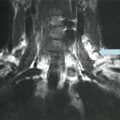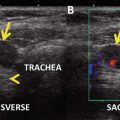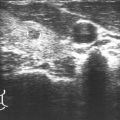© Springer International Publishing Switzerland 2016
David S. Cooper and Cosimo Durante (eds.)Thyroid Cancer10.1007/978-3-319-22401-5_3333. RAI-Refractory Differentiated Thyroid Cancer and Lung Lesions Causing Bleeding
(1)
University of Texas MD Anderson Cancer Center, Unit 1461, 301402, Houston, TX 77230-1402, USA
Keywords
Thyroid carcinomaHemoptysisMetastasisBronchoscopyArgon plasma coagulationLaser resectionMetastasectomyRadiotherapyCase Presentation
A 74-year-old woman presented for her routine follow-up noting recent development of a cough productive of blood-tinged sputum for the past 3 months, not associated with fever, shortness of breath, chest pain, or other systemic symptoms. By her report, she averaged about one to two teaspoons of bloody sputum each morning. Her past history is notable for a 3 cm, locally invasive, poorly differentiated carcinoma of the thyroid, treated with total thyroidectomy 6 years previously. Adjuvant radioiodine, 150 mCi, had been administered, with post-therapy scan uptake noted only in the thyroid bed. Two additional radioiodine treatments had been given during the next 2 years, 180 and 200 mCi, respectively, with concurrent stimulated thyroglobulin levels of about 20 ng/mL, but no pathologic uptake had been noted on post-therapy imaging. One month after her third radioiodine treatment, computed tomography (CT) scans had been performed, demonstrating extensive metastatic adenopathy in bilateral and central neck compartments and bilateral subcentimeter pulmonary nodules. Following a bilateral, central, and mediastinal neck dissection and postoperative adjuvant external beam radiotherapy, her TSH-suppressed serum thyroglobulin level had declined to 2 ng/mL. She had remained clinically and radiographically stable for the intervening 3 years until her current presentation with hemoptysis, although the serum thyroglobulin had risen to 88 ng/mL at her last evaluation 6 months ago. Examination of her upper airway including indirect laryngoscopy demonstrated no focal lesions or bleeding, there were no masses palpated in the neck, and her lungs were clear to percussion and auscultation. With an undetectable serum TSH, her thyroglobulin level was 2241 ng/mL. A CT scan demonstrated an enlarging 1.6 cm pulmonary nodule in the left upper lobe and a 2.5 cm left lower paratracheal mass, along with numerous subcentimeter lung nodules that were unchanged compared with previous imaging studies.
Literature Review
Hemoptysis is commonly a distressing presenting symptom of intrathoracic disease, both benign and malignant [1]. Among patients without a known diagnosis of malignancy who present with mild hemoptysis (defined as blood-tinged or streaked sputum, blood clots, or <20 mL of blood expectorated within 24 h), most will have nonmalignant etiologies of hemoptysis including bronchitis, pneumonia, bronchiectasis, or heart failure [2]. Rarer causes of hemoptysis which also require consideration include pulmonary embolism, vascular malformations, vasculitic disorders, coagulopathies, and immunologic diseases, although many of these conditions are more likely to cause larger amounts of acute bleeding or life-threatening massive hemoptysis [1]. However, in the setting of a preexisting diagnosis of non-hematologic malignancy, fewer than 10 % will be found to have a benign cause of hemoptysis [3]. About half will have primary lung carcinoma, whereas the other half will have metastases from non-thoracic primary malignancies. When an endobronchial lesion is identified by bronchoscopy, carcinomas of the breast, colorectum, kidney, and larynx and melanoma are the most common primaries, whereas thyroid carcinoma accounts for only a few percent of reported cases [2–4]. Upper airway causes of bleeding also need to be considered, including intraluminal invasion of a malignancy of the head and neck and rarer complications of cancer therapy such as a tracheoesophageal fistula after radiation or antiangiogenic therapy.
Given this differential diagnosis, a patient with differentiated thyroid carcinoma (DTC) who develops hemoptysis requires a diagnostic evaluation before planning treatment [1]. The amount of bleeding should be assessed and the risk for hemodynamic compromise considered. Medications should be reviewed for use of anticoagulants, aspirin, and nonsteroidal anti-inflammatory drugs that increase bleeding risk. Given the amount of blood that can be lost either acutely or chronically, blood hematocrit and hemoglobin should be determined along with coagulation parameters. Computed tomography should be performed and compared with any available previous imaging studies to identify new or changing lesions, whereas chest X-ray has a very low sensitivity for identifying the etiology of hemoptysis. Combining chest CT with flexible bronchoscopy maximizes the likelihood of detecting endobronchial metastases [3, 4]. Once a suspicious lesion is visualized by bronchoscopy, a biopsy can be obtained if it is necessary to determine the histology of the tumor; alternatively, transthoracic biopsy (either CT-guided needle biopsy or an excisional procedure) can also be performed if bronchoscopic biopsy is not feasible or unsuccessful. Bronchoscopic findings may also facilitate rapid prognostication. Among patients with solid tumors and hemoptysis, bronchoscopic detection of both active bleeding and an endobronchial lesion portends a worse prognosis with a median survival of 3.5 months, compared with 66 months for those with neither active bleeding nor endobronchial lesion visualized [3]; however, whether this analysis specifically applies to DTC is unknown.
Stay updated, free articles. Join our Telegram channel

Full access? Get Clinical Tree






